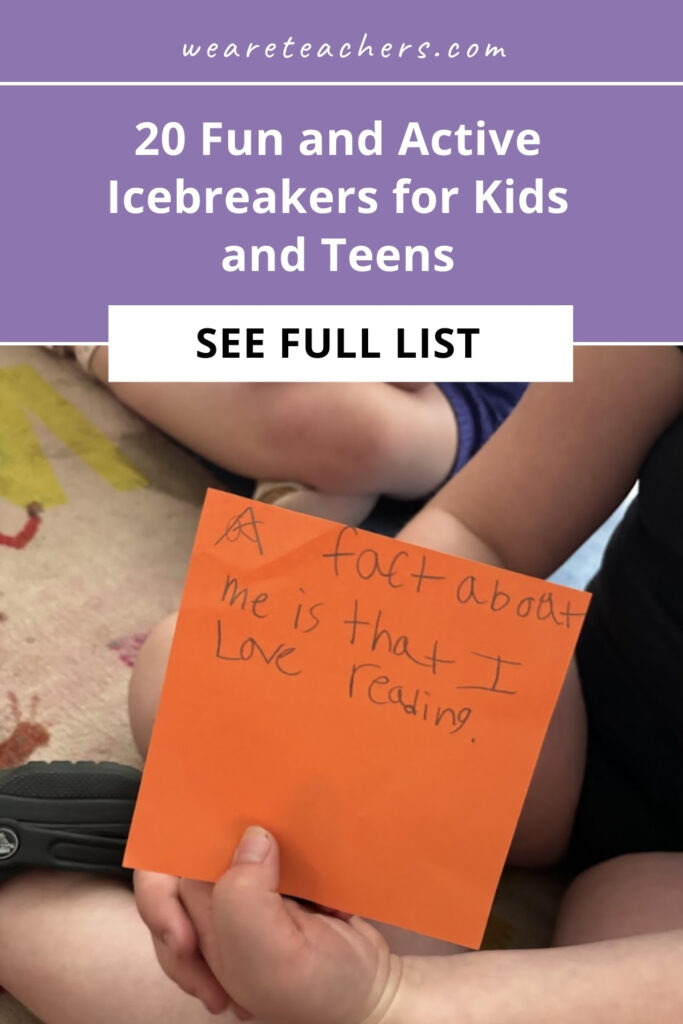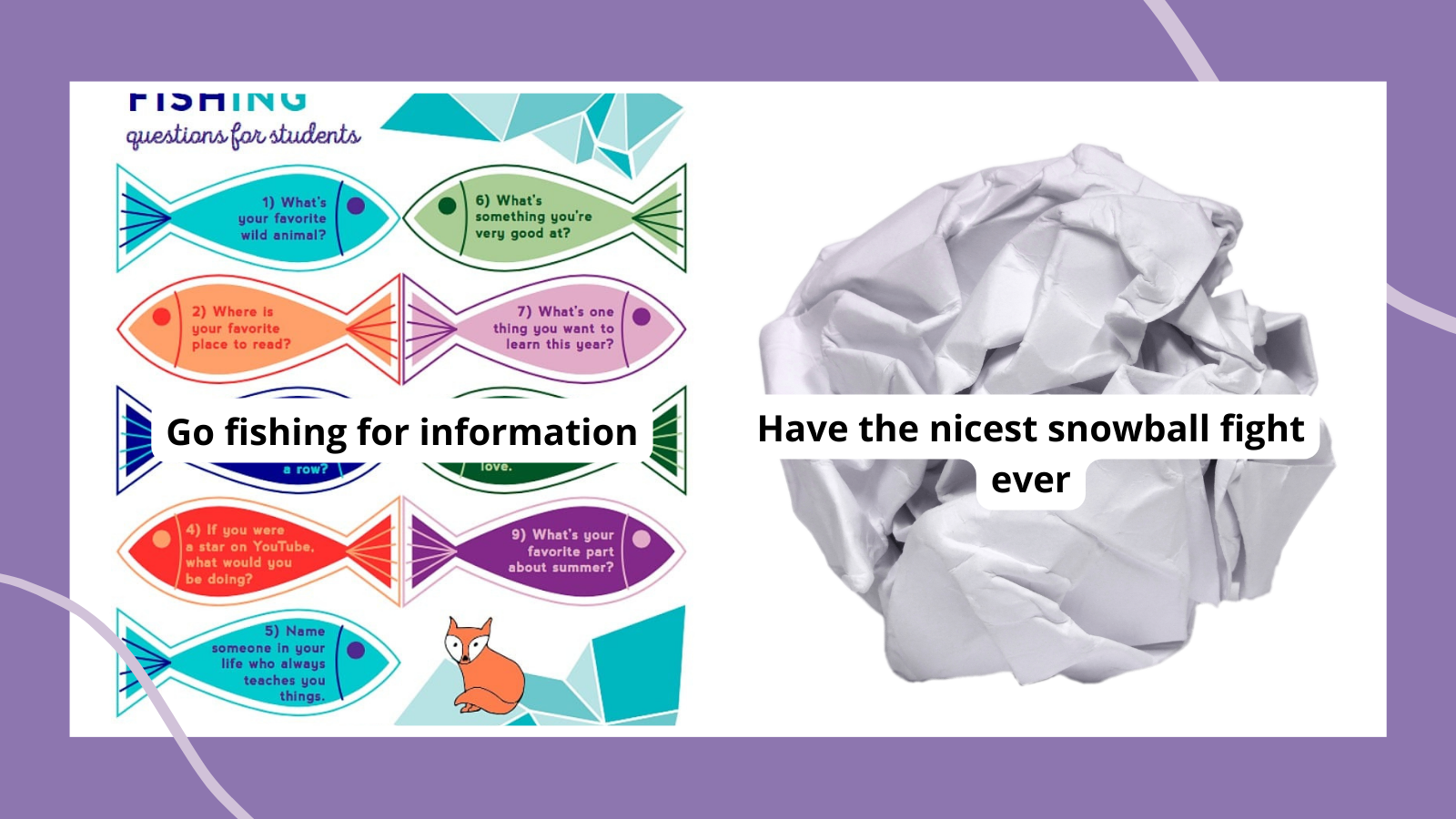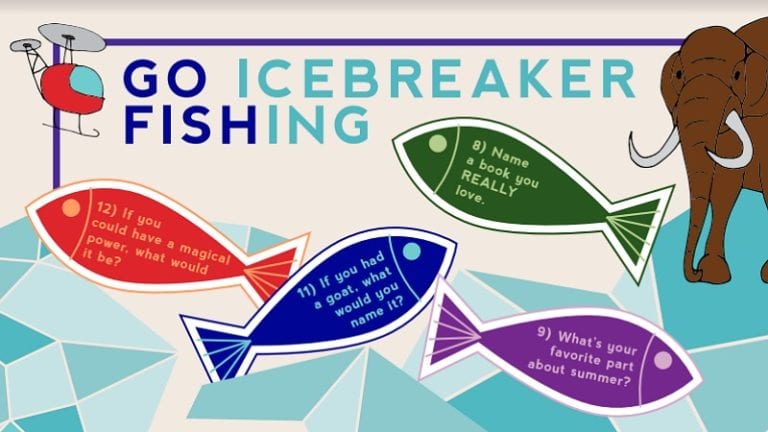Looking for creative getting-to-know-you games to help new groups of students feel more comfortable with each other? These icebreakers for kids and teens encourage them to share and establish a sense of camaraderie. They also get students up and moving, which almost always helps break the ice a little more quickly.
Tip: The best get-to-know-you games ensure everyone can participate equally. If you choose a more active option from our list of icebreakers for kids and teens, think about how you’ll accommodate any students with mobility issues or other challenges.
1. Icebreaker Fishing
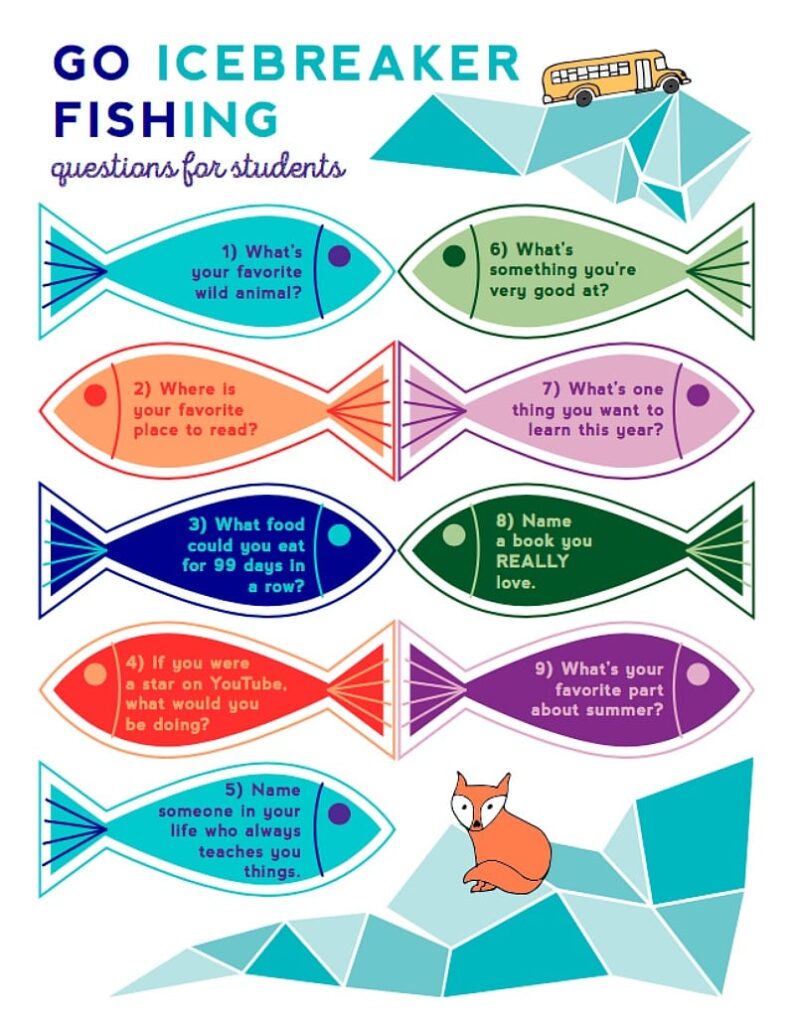
First, grab our free printable icebreaker fish here. Cut them out and attach a paper clip to each, then drop them face down on the floor. Arm kids with a small fishing rod made from a dowel rod, string, and magnet, and ask them to “fish” for a question. Once they land it, they have to answer the question on the fish.
2. Bucket List
Students work in groups to create a bucket list of things they want to do this school year (or in the final month of the school year). Provide slips of paper for them to write each idea, and give each team a bucket spaced at least a few feet away. As they come up with an idea, one person writes it down, crumples it up, and throws it into the bucket. Afterwards, you can review all the ideas and use them to help you plan.
3. Nice Snowball Fight
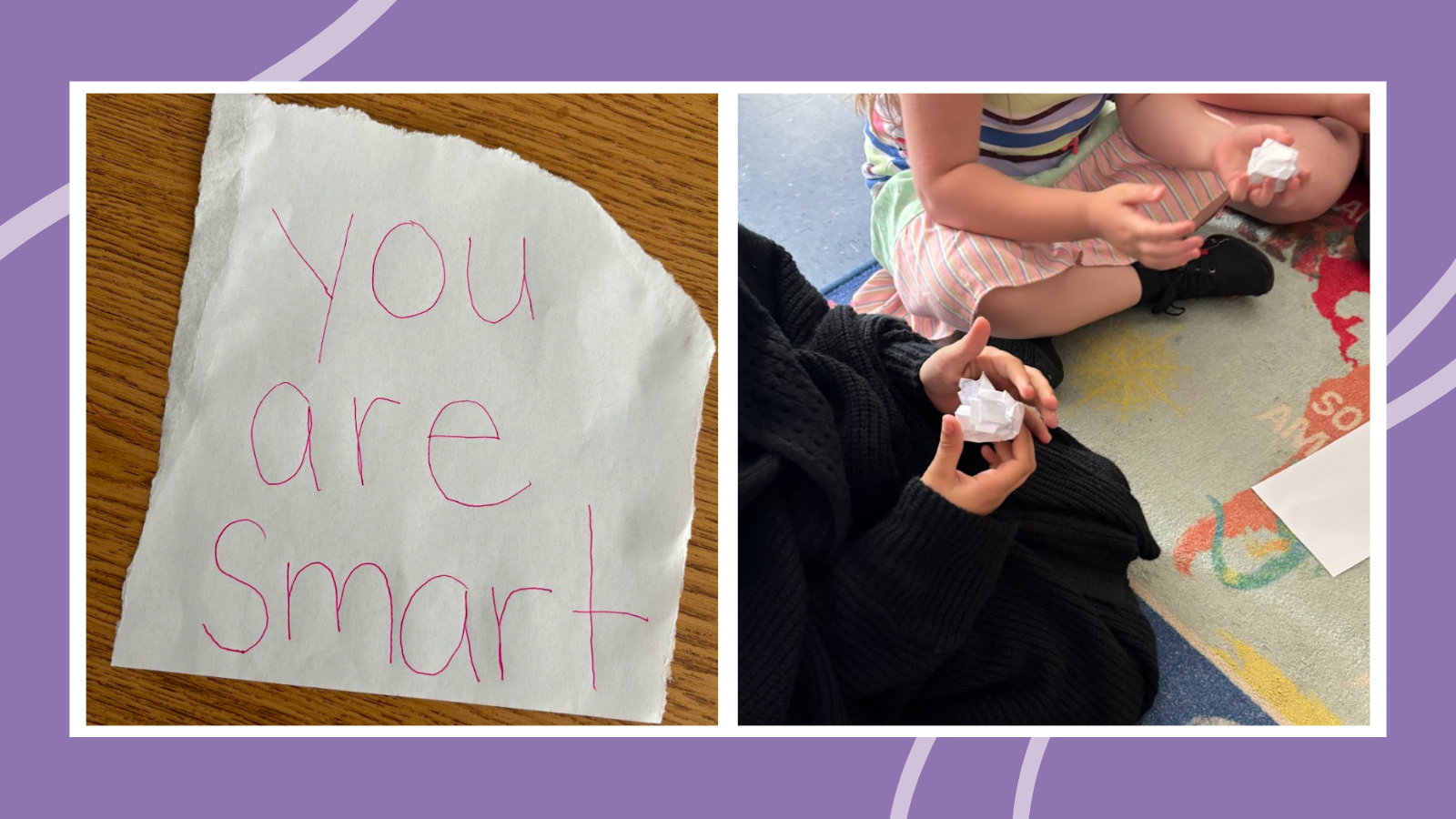
Here’s another chance to throw stuff around the classroom! Students write a positive quote, word of encouragement, or positive picture on a white piece of paper. They then crumple up their own sheet to make a “positive snowball.” Then, ready … aim… FIRE! Watch the positivity fly across the room both figuratively and literally. After a minute or two, stop the chaos and have each kid pick up one random “snowball.” Sit in a circle to open and read the notes out loud. After you’re done, don’t toss ’em. Instead, keep them in the classroom so students can reference them when they need a pick-me-up.
4. Lines and Blobs
This game keeps students moving around freely until the teacher tells them to get in a line or a blob (small group) according to a category. Some prompts to use:
- Line up in birth order (youngest to oldest or oldest to youngest).
- Line up in birthday order from January to December.
- Line up according to how many siblings you have.
- Gather people who are wearing the same color as you.
- Line up in alphabetical order by last name.
- Gather people who come to school in a car, a bus, and on foot.
- Gather people who prefer reading books, watching movies, listening to music, or going outdoors.
5. Class Chant
Have your students create a class chant with hand motions or even dance moves. Not only does this instantly bring the group together, it also gives you a preview of the unique personalities you’ll be seeing all year. Use the chant as a tool to call students in for recess, a call-and-response to signify quiet time, or even just for fun!
6. Four Corners
Label four corners or spaces in the room one to four. Then, have students gather according to how they rate themselves on a question or statement. For example, say, “I like to play sports” or “I like spending time by myself.” Kids move to the corner that describes how much they agree with that statement, one being “not at all” and four being “very much.”
7. Beach Ball Toss
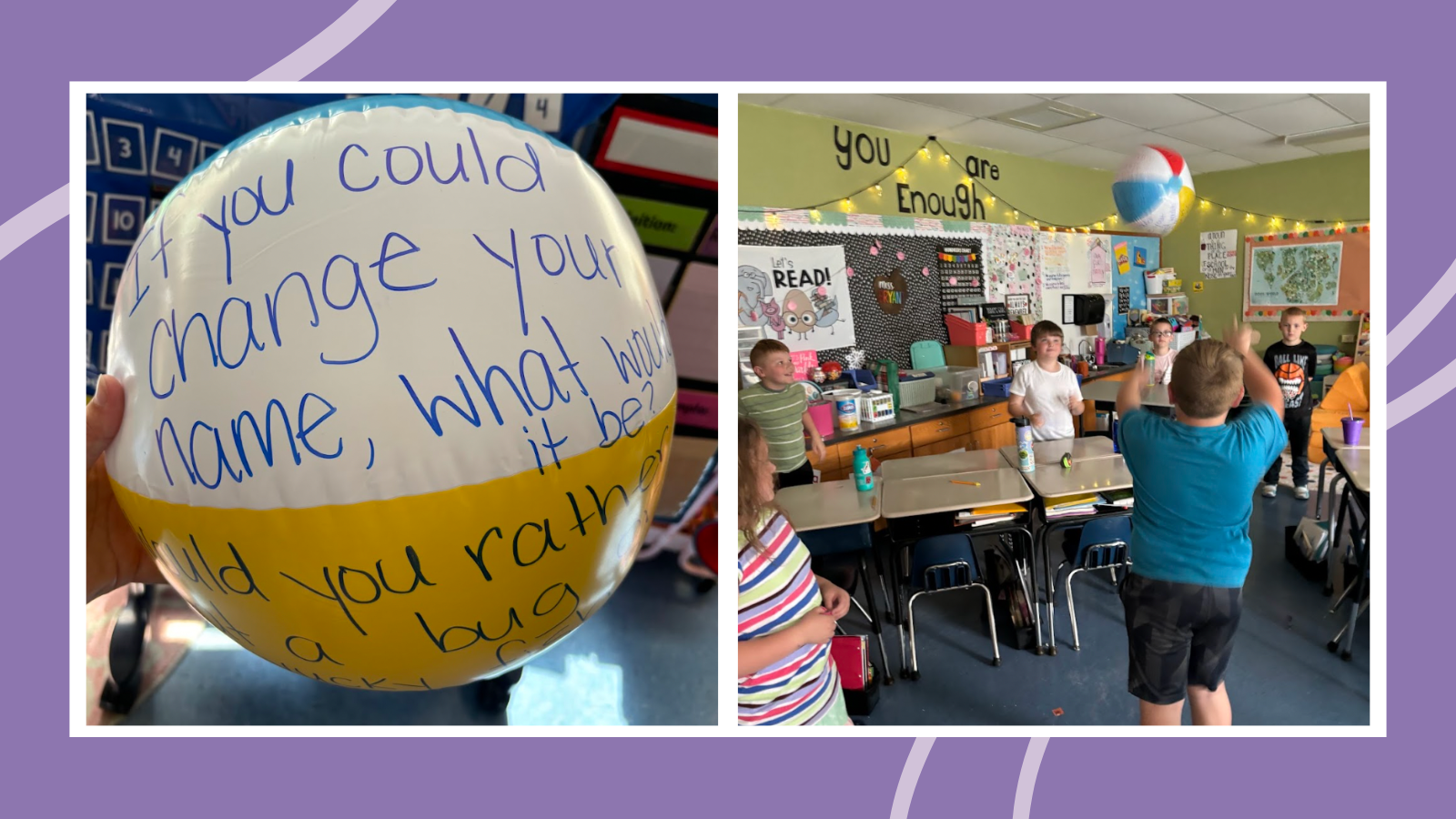
Write icebreaker questions (find our huge list here) on a beach ball. Toss the ball to a student. Have them look at the ball and answer the question that’s closest to their right thumb. Continue tossing and answering until everyone has had at least one turn.
8. This or That?
Put a line (or imaginary line) down the middle of the room. Give students a question that has two options. Have students move to the side of the room that they agree with or prefer. Some prompts:
- Hot dogs or hamburgers?
- Ice cream or cake?
- Mountains or beach?
- Hot or cold?
- Fall or spring?
- Winter or summer?
- Airplane or car?
- Pencils or pens?
- College-ruled or wide-ruled notebook?
- Watch the movie or read the book?
9. Would You Rather?
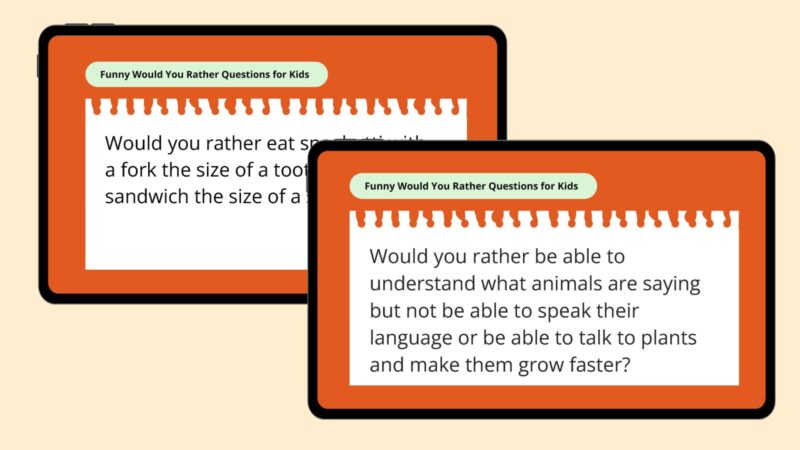
This active icebreaker for kids is similar to This or That but it uses Would You Rather questions instead. Once kids have responded to a question, ask a few from each side to explain their point of view, trying to convince people from the other side to change their minds and move to the other side. The conversation and debate is often hilarious! Find a big list of Would You Rather questions for kids and teens here.
10. Moving Names
This is a fun and active way to get to know everyone’s name. One at a time, each student says their name and accompanies it with a physical motion. The rest of the group says their name and repeats the motion. This is one of those active icebreakers for kids that’s practical too, since students are more likely to remember names when they’re associated with an action.
11. Class Bingo
This is one of those classic active icebreakers for kids. Students circulate and chat, looking for people who can initial a free space on their bingo card of get-to-know-you questions. (For an example, see our End-of-Year Bingo card here.) Provide small prizes to anyone who gets a bingo in a set amount of time, or see who can complete the most squares before the time is up. Tip: For more of a challenge, tell kids they can only initial one square per bingo card.
12. Stand Up, Sit Down
Seat students in a circle. Call out a get-to-know-you question like “I love the color blue” or “I’ve been to another country.” If the answer is yes, students stand up. For no, they sit. For a more active version, have kids sit on the floor; make things a little easier by having them sit in chairs instead.
13. Keepy Uppy
Give each child a small piece of paper and have them write one unique fun fact about themselves (no names!). Fold them up and slip each into an uninflated balloon, then blow up the balloons. Start some music and play an epic game of Keepy Uppy with the balloons for a few minutes. Afterwards, each child grabs a balloon of a different color than the one they started with. Take turns popping the balloons and reading the statements out loud. The class works together to try to guess who the statement describes.
14. Spell My Name
Kids take turns spelling their name by forming shapes with their bodies. As other students call out each letter, write it on the board for all to see. Get-to-know-you icebreakers like this one encourage kids to not only learn each other’s names but how to spell and pronounce them too.
15. Three of a Kind
In this active icebreaker, the goal is to form groups of three people and determine what they have in common. For instance, all three kids might learn they all like pineapple on their pizza or speak more than one language at home. After a minute, ask each group to share their common trait, then mix up the groups and repeat. (If your class doesn’t divide evenly by three, try four instead.)
16. Speed Chatting
Think of this a little like speed dating. Have kids sit in two even rows, facing each other to form pairs. Set a timer for two minutes, and have students introduce themselves and chat to learn a little more about each other. When the time is up, have students in one row each move one seat to the right (the person at the end of the line goes back around to the beginning). Continue until all pairs have had a chance to chat.
17. Paper Planes
Each student writes a get-to-know-you question on a piece of paper. (Encourage them to think creatively so you don’t wind up with the same question over and over again.) Then, they fold the paper into planes and spend a minute throwing them across the room. Afterwards, everyone picks up a plane and they take turns answering the question on theirs.
18. Find Me!
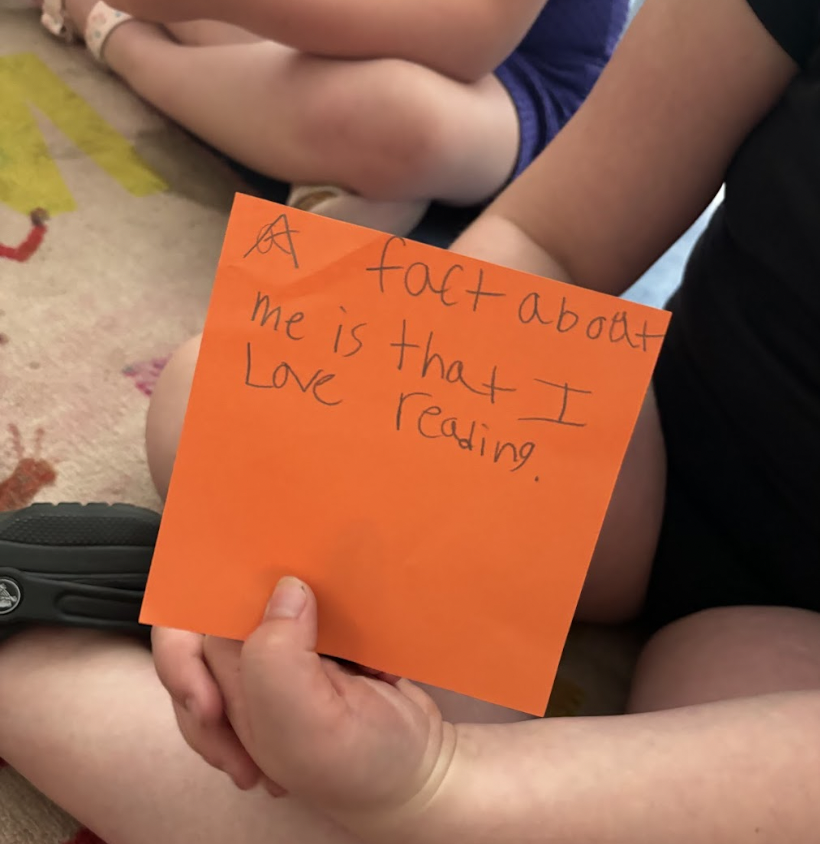
Each student writes an original and unique fact about themselves on a note card. Mix up the cards and pass them out again, then ask each kid to find the person whom their note card describes. You can repeat this again and again with new facts if you like.
19. Get-to-know-you Jenga
Pick up an inexpensive Jenga set at the dollar store, then write an icebreaker question on each piece. Pile them up so kids can’t see what the questions are on each block. One by one, students pull a block and answer the question that’s written on it. (If the block topples before everyone has answered, restack and keep on going.)
20. Switch It
Students sit in a circle for this active icebreaker. Stand in the center and call out a statement like “I’ve been to another country” or “My favorite sport is baseball.” If a student agrees with the statement, they stand up and quickly switch seats with another person who also agrees. One rule: Two students sitting next to each other can’t switch seats. If there’s no available seat for a student, they remove their chair and join you in the center. Keep going until everyone is in the middle!
What are your favorite active get-to-know-you games and icebreakers for kids? Share your ideas and ask for advice in the We Are Teachers HELPLINE group on Facebook!
Plus, for more icebreakers for kids and activities, check out Awesome Team-Building Activities for Kids.
